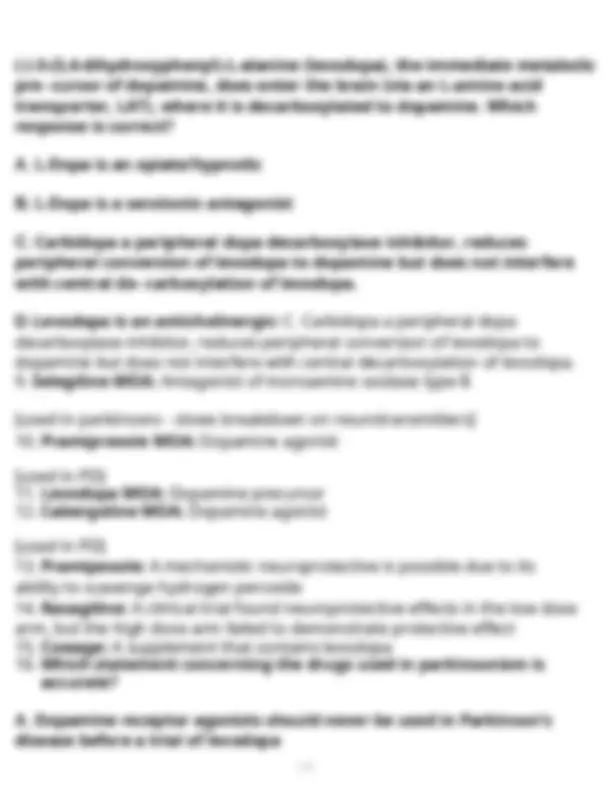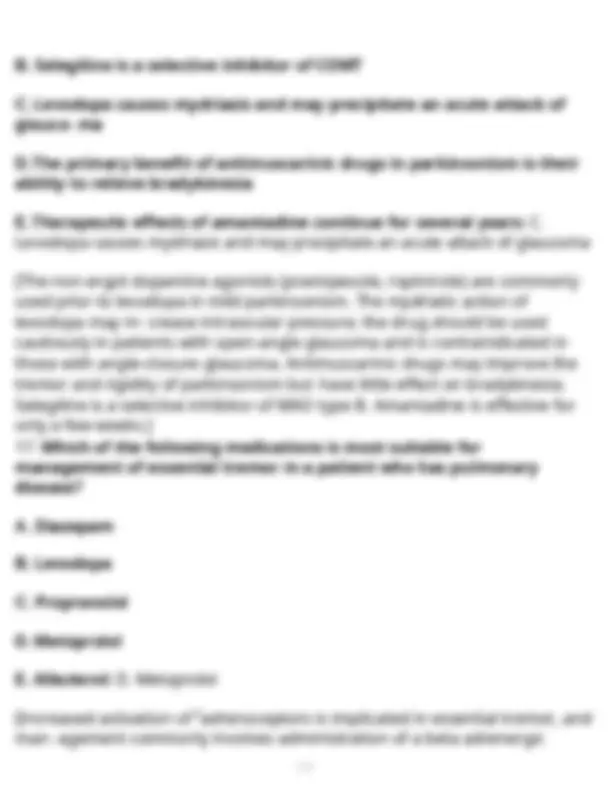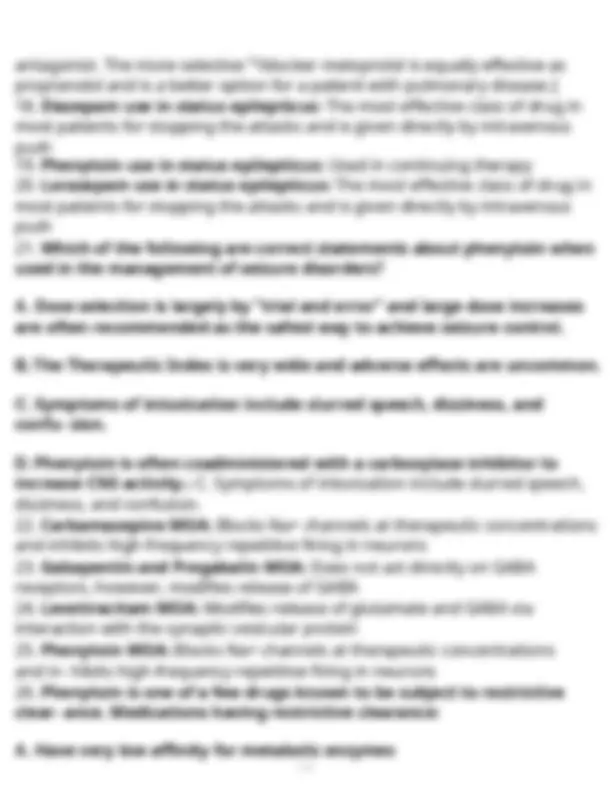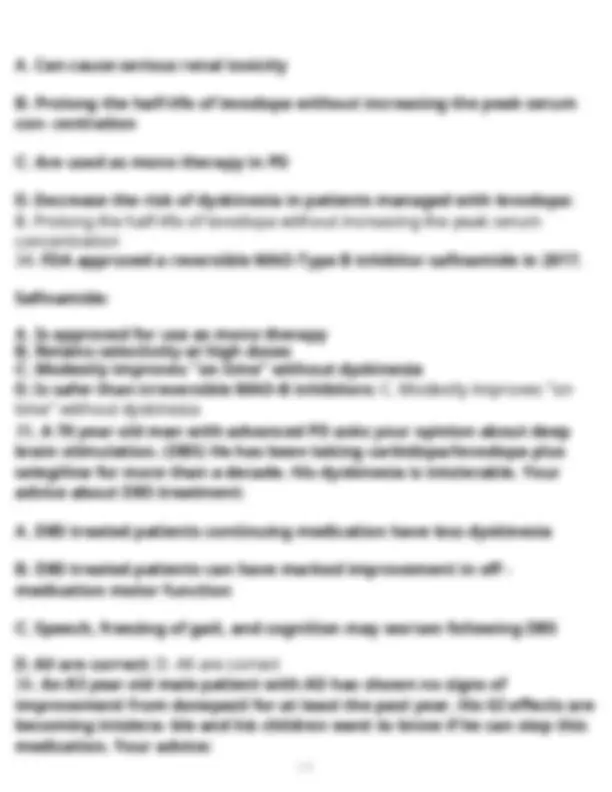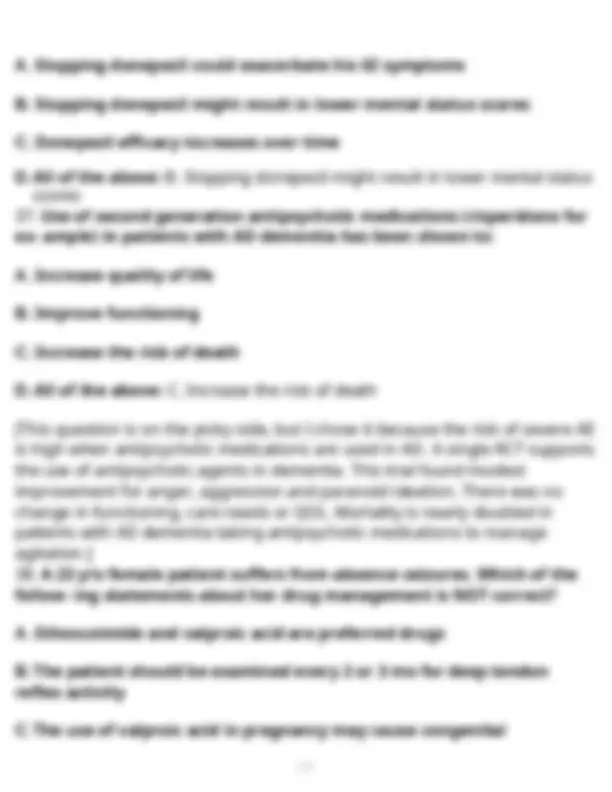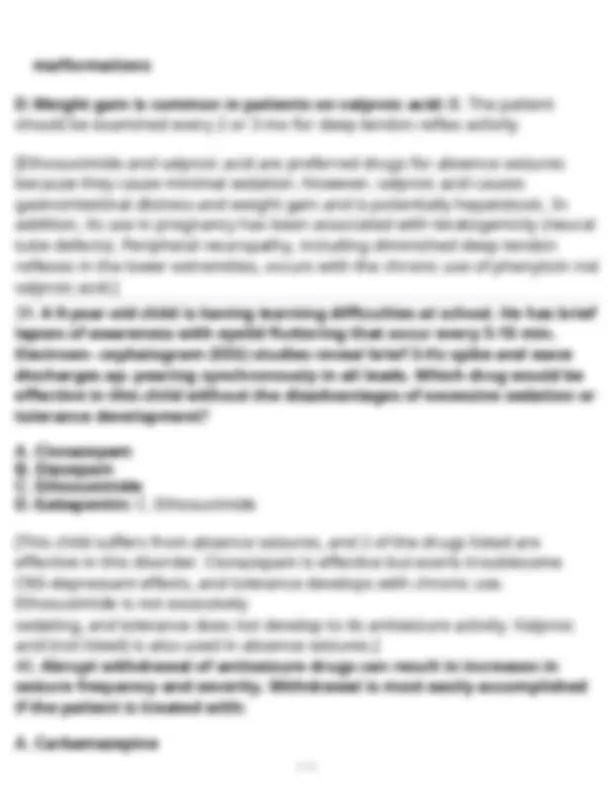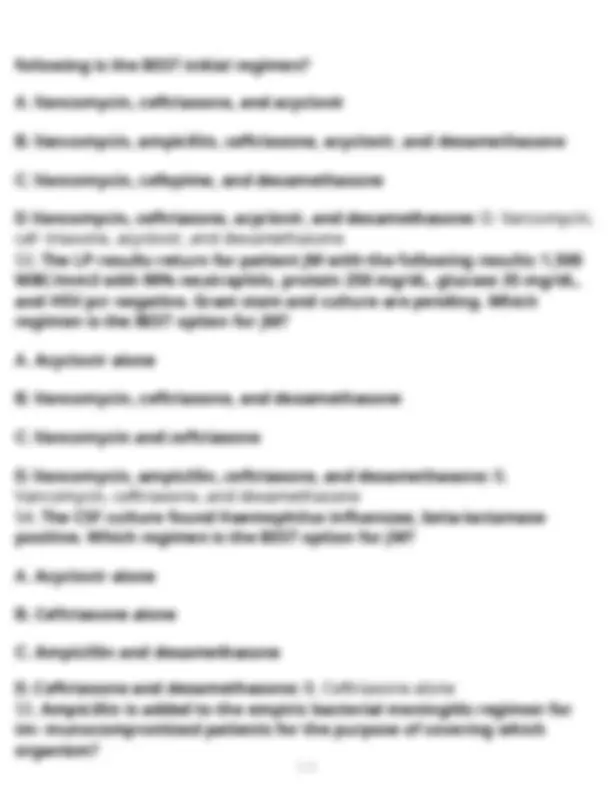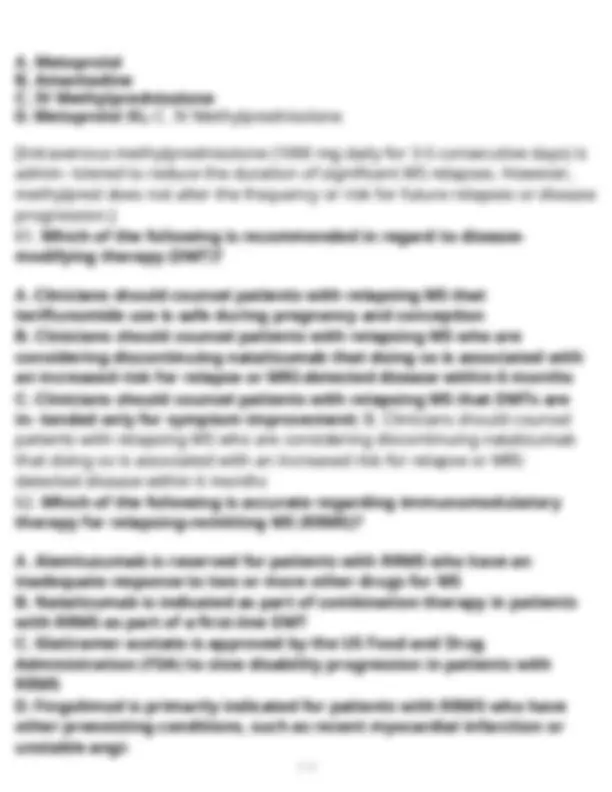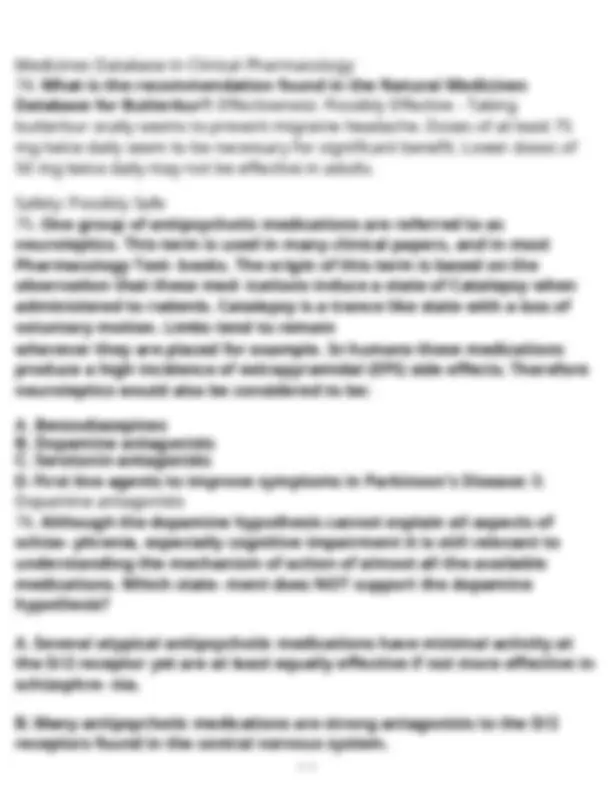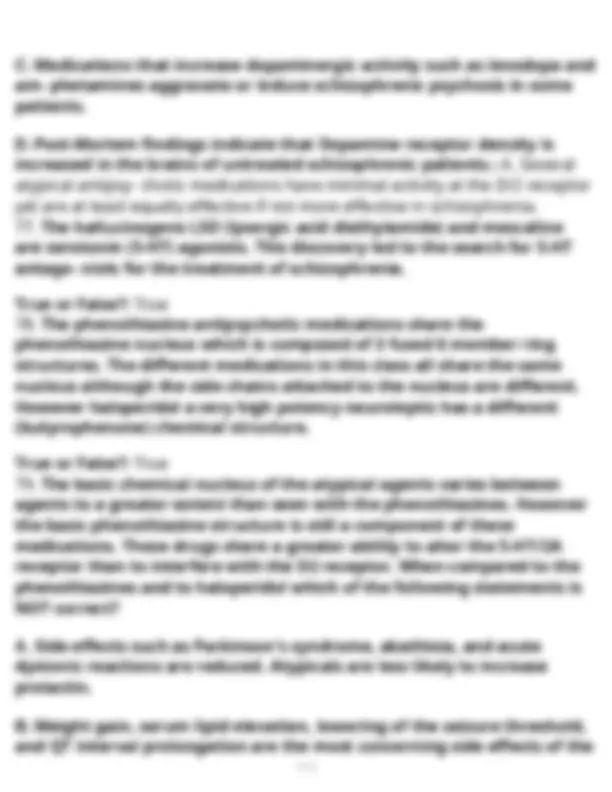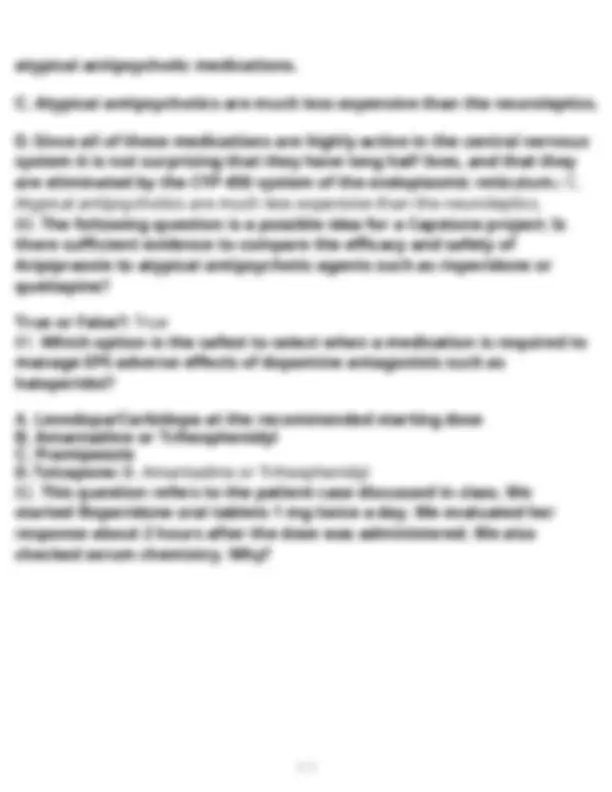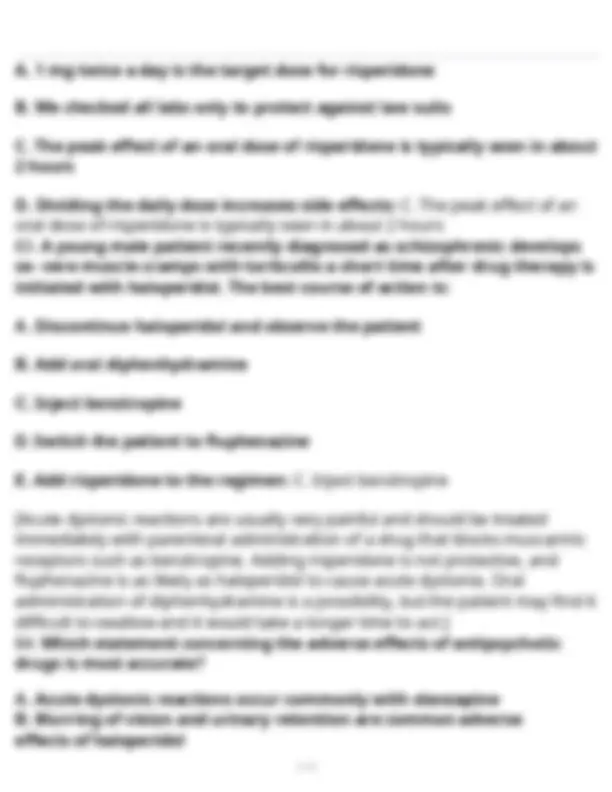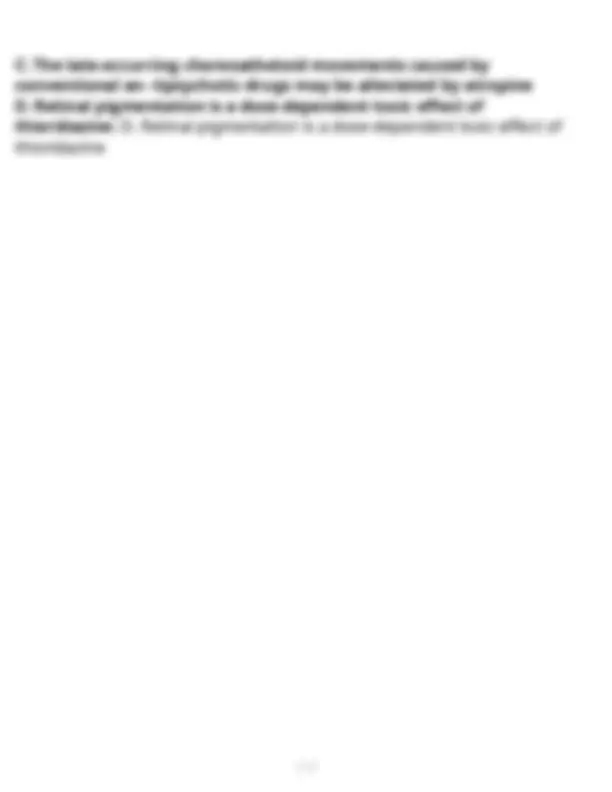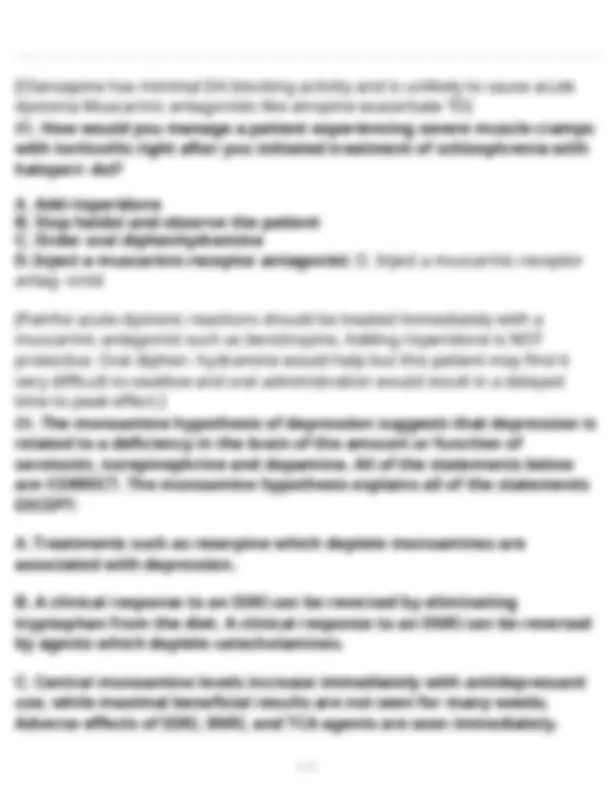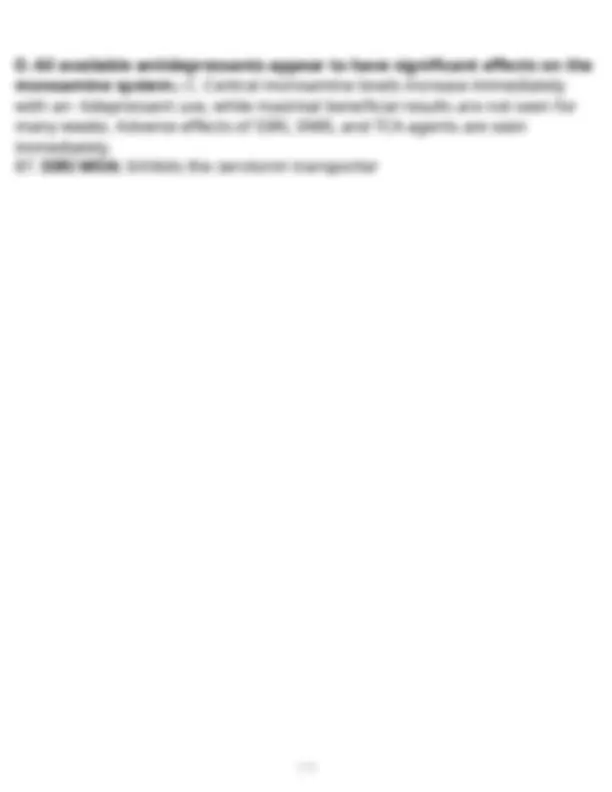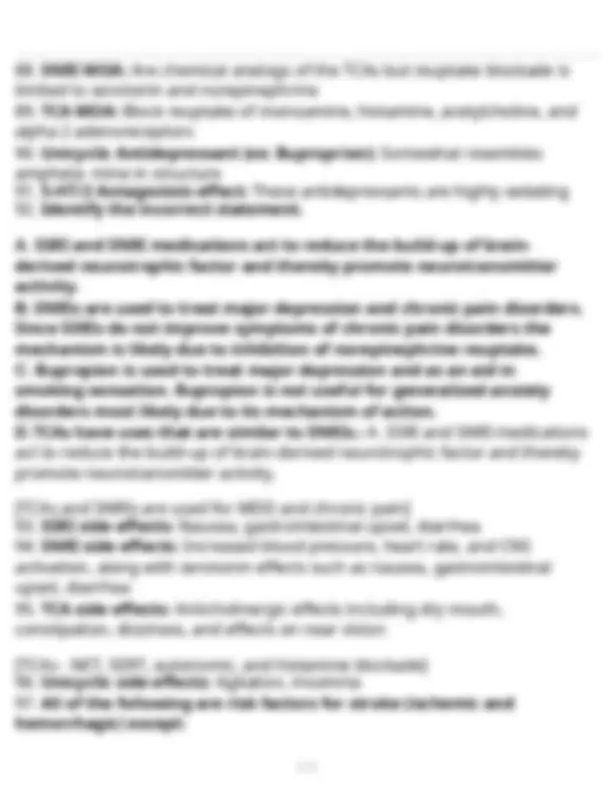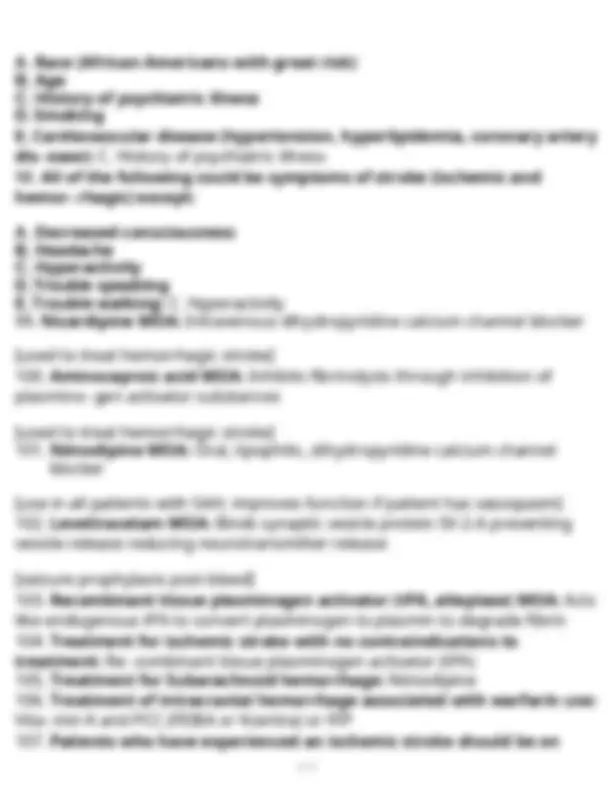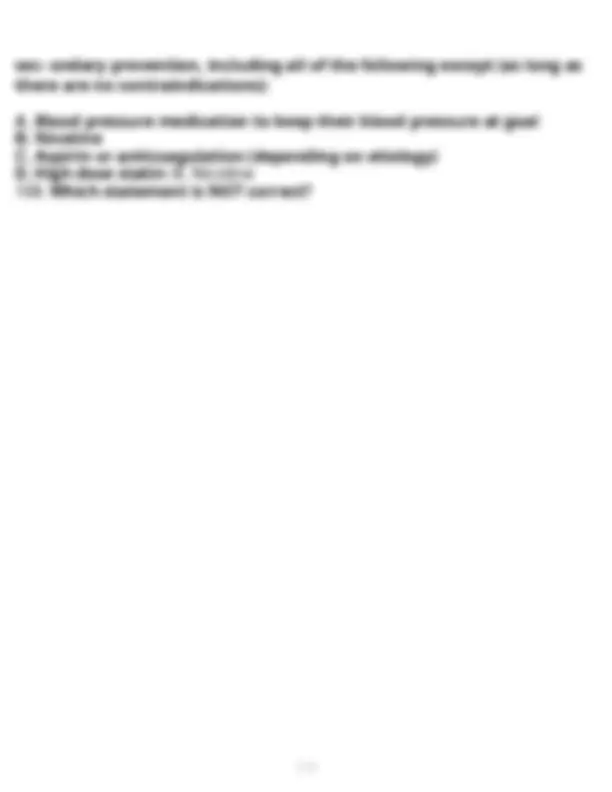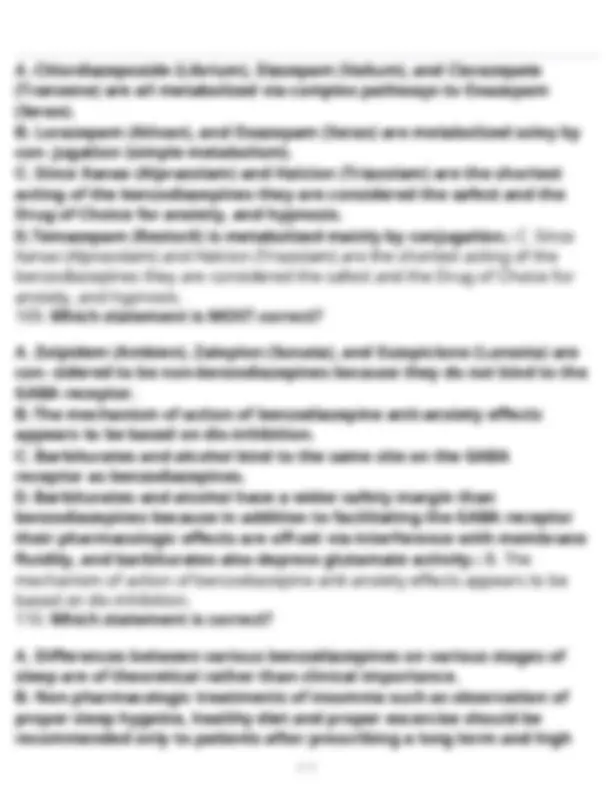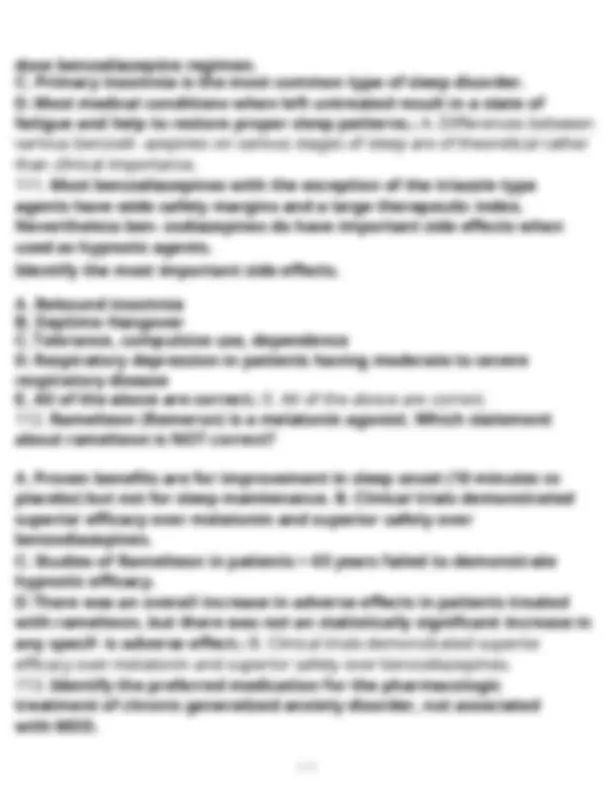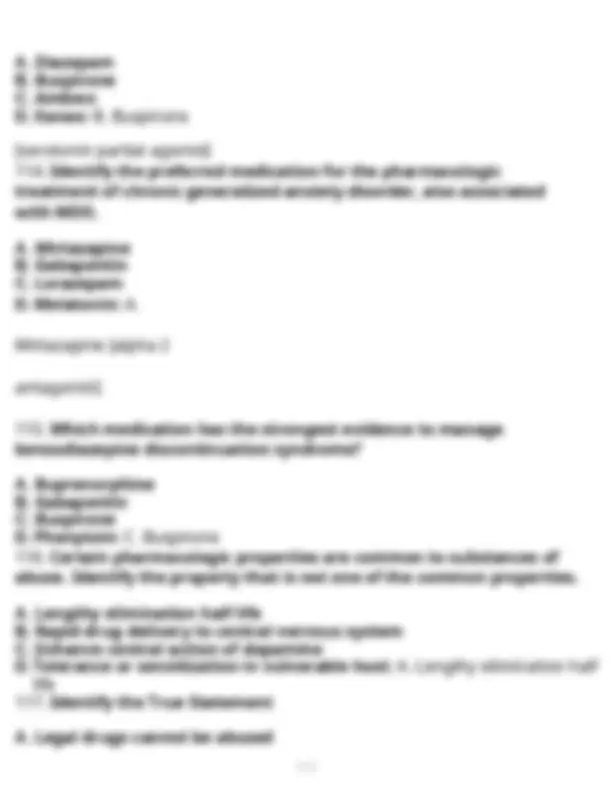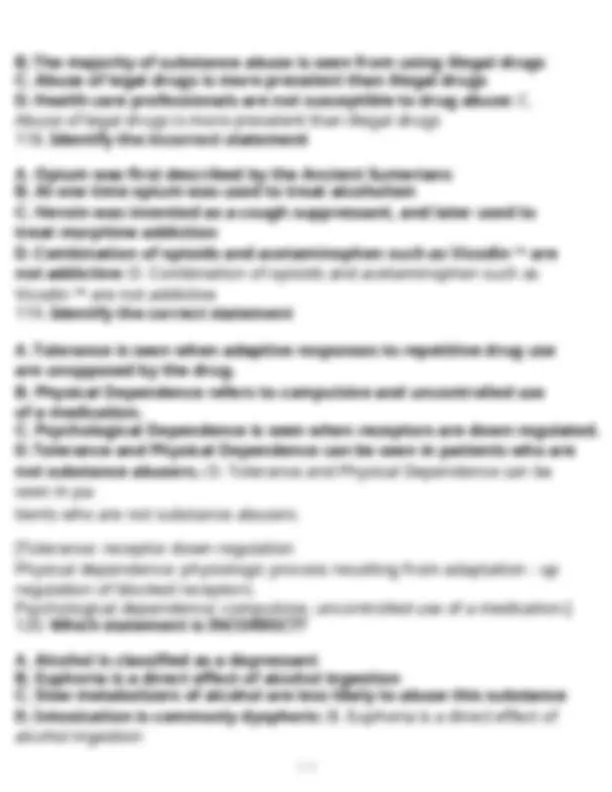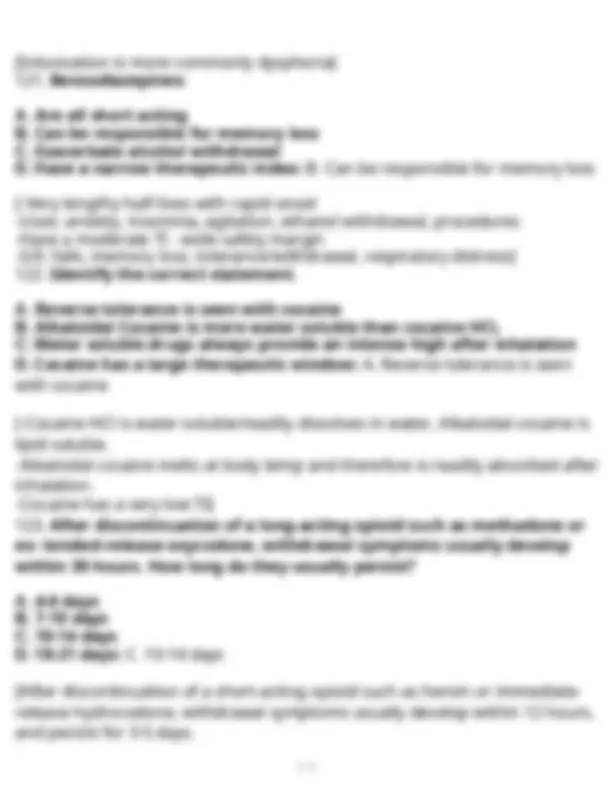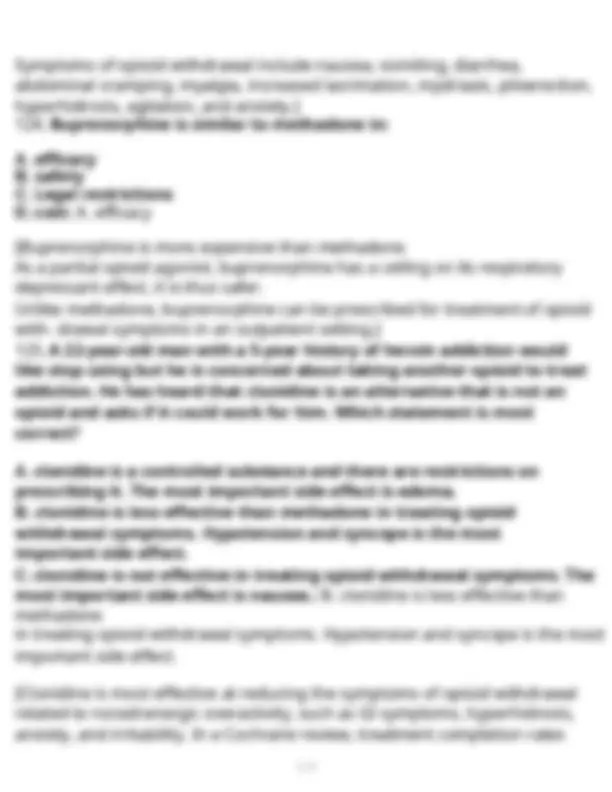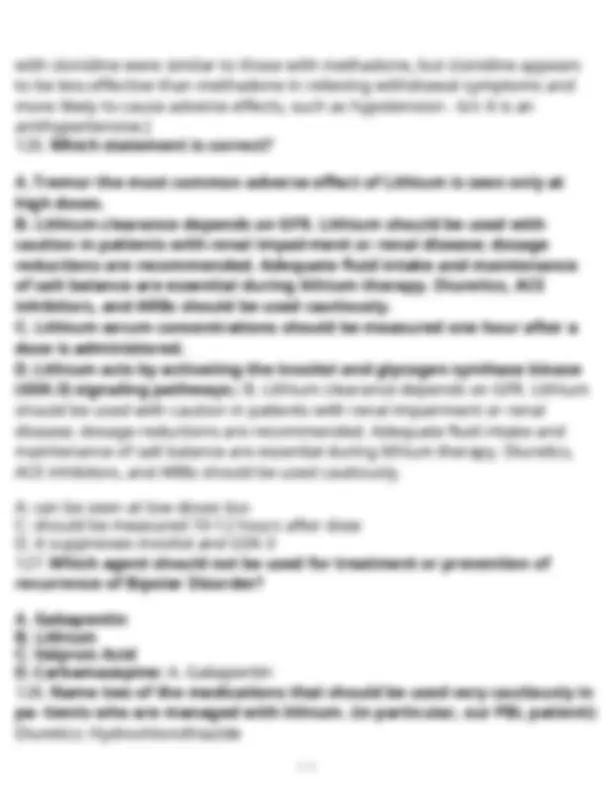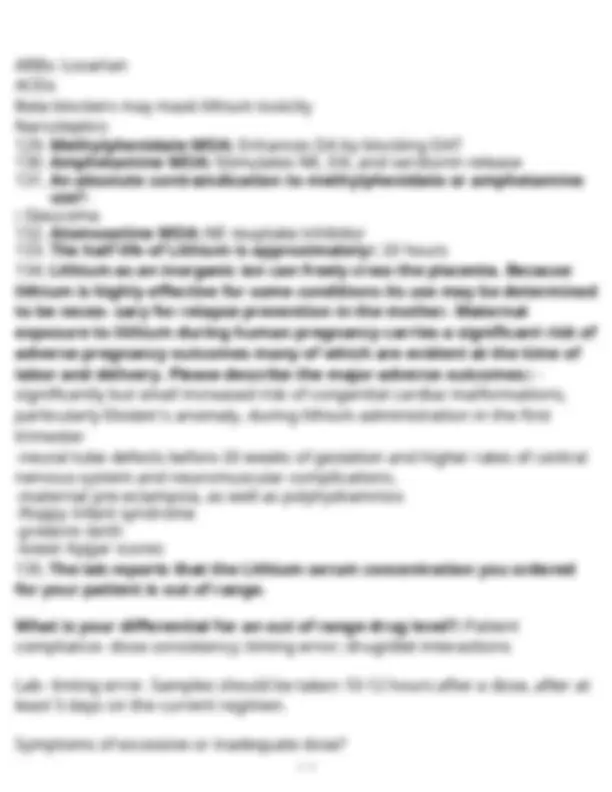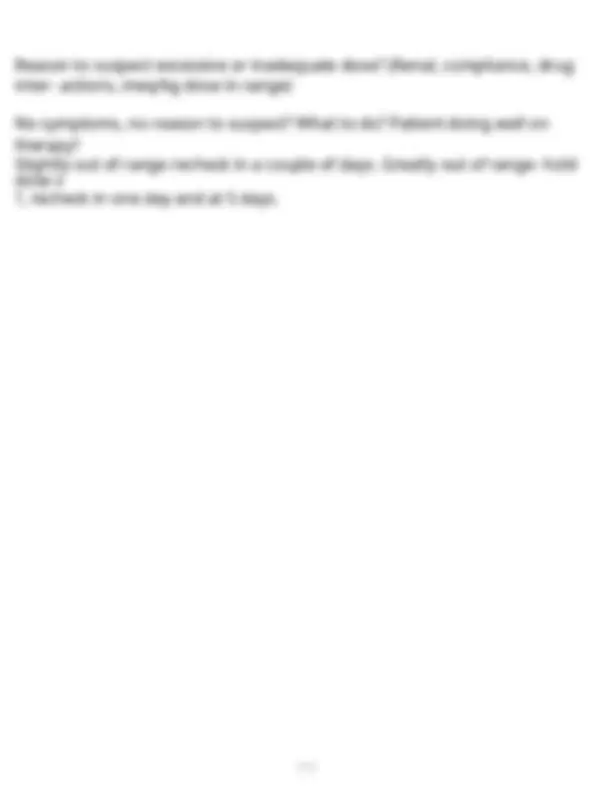Download MCQ 5 – Pharm practice questions with answers detailed[2024-2025] and more Exams Nursing in PDF only on Docsity!
MCQ 5 – Pharm practice questions with answers
detailed[2024-2025]
- Consider acetylcholine's role as a neurotransmitter. A. Acetylcholine is generally an inhibitory neurotransmitter B. Excitatory transmitter acting on the N-Methyl-d-aspartate (NMDA) receptor. C. Is an excitatory neurotransmitter effecting memory and cognition in the cerebral cortex and opposing dopamine in the basal ganglia. D. Serves an excitatory role by inhibiting GABA receptors: C. Is an excitatory neurotransmitter effecting memory and cognition in the cerebral cortex and opposing dopamine in the basal ganglia.
- Dopamine, Epinephrine and Norepinephrine are catecholamines. True or False?: True
- Serotonin inhibits the GABA receptor. True or False?: False
- Dopamine is a neurotransmitter for pathways that influence motor control, mood and emotion, and also nausea and vomiting. True or False?: True
- 5-Hydroxytryptamine is a neurotransmitter for pathways that influence pain; mood and behavior; depression and anxiety; and nausea and vomiting. True or False?: True
- Which statement best describes the properties of centralling acting medica- tions: A. Can be taken orally; poorly soluble in water; complex metabolism and low extraction; large distribution volumes and lengthy half lives. Narrow Therapeu- tic Index (TI)
B. Must be injected, eliminated by the kidney, short half lives; high therapeutic index. C. Can be taken orally; poorly soluble in water; high hepatic extraction; large distribution volumes and lengthy half lives. Narrow TI D. Can be taken orally; highly soluble in water; complex metabolism and low extraction; large distribution volumes and lengthy half lives. Wide TI: A. Can be taken orally; poorly soluble in water; complex metabolism and low extraction; large distribution volumes and lengthy half lives. Narrow Therapeutic Index (TI)
- What is the risk of taking warfarin and duloxetine concurrently? 2. When do you predict to see the peak effect of adding duloxetine to warfarin? 3. Discuss your plan. Are you going to continue warfarin? If yes why? If not why, and what are your going to do about her thrombotic problem?: 1. Considered a major interaction. As duloxetine depletes platelet serotonin.The risk of bleeding complications is elevated. PT/INR and aPTT may or may not be effected by this interaction. Patient should be advised.
- The half life of warfarin and of many of the clotting factors influenced by warfarin is lengthy. The half life of duloxetine is also fairly lengthy (half a day to a full day). One to two weeks to see the full effect of the interaction, however the intensity can continue to increase over time.
- She is doing very well on warfarin, and has difficulty with NPP. Can continue both medications if your patient is reliable about her appointments, has a good health literacy and is willing to continue on this option. Do check to see how she responds to duloxetine before committing to a long term regimen.
- Dopamine does not cross the blood-brain barrier and if given into the peripheral circulation has no therapeutic effect in parkinsonism. However,
B. Selegiline is a selective inhibitor of COMT C. Levodopa causes mydriasis and may precipitate an acute attack of glauco- ma D. The primary benefit of antimuscarinic drugs in parkinsonism is their ability to relieve bradykinesia E. Therapeutic effects of amantadine continue for several years: C. Levodopa causes mydriasis and may precipitate an acute attack of glaucoma [The non-ergot dopamine agonists (pramipexole, ropinirole) are commonly used prior to levodopa in mild parkinsonism. The mydriatic action of levodopa may in- crease intraocular pressure; the drug should be used cautiously in patients with open-angle glaucoma and is contraindicated in those with angle-closure glaucoma. Antimuscarinic drugs may improve the tremor and rigidity of parkinsonism but have little effect on bradykinesia. Selegiline is a selective inhibitor of MAO type B. Amantadine is effective for only a few weeks.]
- Which of the following medications is most suitable for management of essential tremor in a patient who has pulmonary disease? A. Diazepam B. Levodopa C. Propranolol D. Metoprolol E. Albuterol: D. Metoprolol [Increased activation of ²adrenoceptors is implicated in essential tremor, and man- agement commonly involves administration of a beta adrenergic
antagonist. The more selective ²1blocker metoprolol is equally effective as propranolol and is a better option for a patient with pulmonary disease.]
- Diazepam use in status epilepticus: The most effective class of drug in most patients for stopping the attacks and is given directly by intravenous push
- Phenytoin use in status epilepticus: Used in continuing therapy
- Lorazepam use in status epilepticus: The most effective class of drug in most patients for stopping the attacks and is given directly by intravenous push
- Which of the following are correct statements about phenytoin when used in the management of seizure disorders? A. Dose selection is largely by "trial and error" and large dose increases are often recommended as the safest way to achieve seizure control. B. The Therapeutic Index is very wide and adverse effects are uncommon. C. Symptoms of intoxication include slurred speech, dizziness, and confu- sion. D. Phenytoin is often coadministered with a carboxylase inhibitor to increase CNS activity.: C. Symptoms of intoxication include slurred speech, dizziness, and confusion.
- Carbamazepine MOA: Blocks Na+ channels at therapeutic concentrations and inhibits high-frequency repetitive firing in neurons
- Gabapentin and Pregabalin MOA: Does not act directly on GABA receptors, however, modifies release of GABA
- Levetiracitam MOA: Modifies release of glutamate and GABA via interaction with the synaptic vesicular protein
- Phenytoin MOA: Blocks Na+ channels at therapeutic concentrations and in- hibits high-frequency repetitive firing in neurons
- Phenytoin is one of a few drugs known to be subject to restrictive clear- ance. Medications having restrictive clearance: A. Have very low affinity for metabolic enzymes
D. Agitation when seen in conjunction with AD should be conservatively managed using neuroleptics only when other measures fail and using low dose neuroleptics for short periods of time.: A. Anticholinergic adverse effects of cholinesterase inhibitors are best managed with a scopolamine patch. [Scopolamine is anticholinergic]
- In class we discussed the case of a 74F patient with AD successfully managed with donepezil and multiple non-pharmacologic methods. For the past two months she reports urinary frequency, and burning on urination. She has had episodes of urinary incontinence managed with daily oxybutynin since this December. In the past month (February) her personality has changed from cooperative to non-cooperative, she displays lack of interest, apathy and tearfulness. Her MMSE assessment has significantly deteriorated since her last visit 2 months previous. This patient significantly improved after: A. Increasing the dose of donepezil, and adding Memantine B. Adjusting her dose of thyroid replacement C. Discontinue oxybutynin, and work up and then treatment of lower UTI. D. Switching from donepezil to topical Rivastigmine: C. Discontinue oxybutynin, and work up and then treatment of lower UTI.
- After approximately 5-8 years of carbidopa/levodopa treatment most pa- tients develop: A. Nausea and vomiting B. Severe Constipation C. Motor fluctuations and dyskinesia D. Cognitive impairment: C. Motor fluctuations and dyskinesia
- COMT inhibitors:
A. Can cause serious renal toxicity B. Prolong the half-life of levodopa without increasing the peak serum con- centration C. Are used as mono therapy in PD D. Decrease the risk of dyskinesia in patients managed with levodopa: B. Prolong the half-life of levodopa without increasing the peak serum concentration
- FDA approved a reversible MAO-Type B inhibitor safinamide in 2017. Safinamide: A. Is approved for use as mono therapy B. Retains selectivity at high doses C. Modestly improves "on time" without dyskinesia D. Is safer than irreversible MAO-B inhibitors: C. Modestly improves "on time" without dyskinesia
- A 70 year old man with advanced PD asks your opinion about deep brain stimulation. (DBS) He has been taking carbidopa/levodopa plus selegiline for more than a decade. His dyskinesia is intolerable. Your advice about DBS treatment: A. DBS treated patients continuing medication have less dyskinesia B. DBS treated patients can have marked improvement in off - medication motor function C. Speech, freezing of gait, and cognition may worsen following DBS D. All are correct: D. All are correct
- An 83 year old male patient with AD has shown no signs of improvement from donepezil for at least the past year. His GI effects are becoming intolera- ble and his children want to know if he can stop this medication. Your advice:
malformations D. Weight gain is common in patients on valproic acid: B. The patient should be examined every 2 or 3 mo for deep tendon reflex activity [Ethosuximide and valproic acid are preferred drugs for absence seizures because they cause minimal sedation. However, valproic acid causes gastrointestinal distress and weight gain and is potentially hepatotoxic. In addition, its use in pregnancy has been associated with teratogenicity (neural tube defects). Peripheral neuropathy, including diminished deep tendon reflexes in the lower extremities, occurs with the chronic use of phenytoin not valproic acid.]
- A 9-year-old child is having learning difficulties at school. He has brief lapses of awareness with eyelid fluttering that occur every 5-10 min. Electroen- cephalogram (EEG) studies reveal brief 3-Hz spike and wave discharges ap- pearing synchronously in all leads. Which drug would be effective in this child without the disadvantages of excessive sedation or tolerance development? A. Clonazepam B. Diazepam C. Ethosuximide D. Gabapentin: C. Ethosuximide [This child suffers from absence seizures, and 2 of the drugs listed are effective in this disorder. Clonazepam is effective but exerts troublesome CNS-depressant effects, and tolerance develops with chronic use. Ethosuximide is not excessively sedating, and tolerance does not develop to its antiseizure activity. Valproic acid (not listed) is also used in absence seizures.]
- Abrupt withdrawal of antiseizure drugs can result in increases in seizure frequency and severity. Withdrawal is most easily accomplished if the patient is treated with: A. Carbamazepine
B. Clonazepam C. Ethosuximide D. Phenobarbital: C. Ethosuximide [Dose tapering is an important principle in antiseizure drug withdrawal. As a rule, withdrawal from drugs used for absence seizures such as ethosuximide is easier than withdrawal from drugs used for partial and tonic-clonic seizures. Withdrawal is most difficult in patients who have been treated with barbiturates and benzodi- azepines.]
- A 16 y/o male patient suffers from a seizure disorder characterized by tonic rigidity of the extremities followed in 15-30 s of tremor progressing to massive jerking of the body. This clonic phase lasts for 1 or 2 min, leaving him in a stuporous state. Of the following drugs, which is most suitable for long-term management of this patient? A. Clonazepam B. Ethosuximide C. Phenytoin D. regabalin: C. Phenytoin [This patient is suffering from generalized tonic-clonic seizures. For many years, the drugs of choice in this seizure disorder have been carbamazepine, phenytoin or valproic acid. However, many newer drugs are also effective, including gabapentin, lamotrigine, levetiracetem, topiramate, and zonisamide. Clonazepam and ethosux- imide are not effective in this type of seizure disorder. Pregabalin is approved for use only in partial seizures.]
- Treatment of partial seizures: Phenytoin, carbamazepine
- Treatment of tonic-clonic seizures: Phenytoin, carbamazepine, valproate
- Treatment of absence seizures: Ethosuximide, valproate *Phenytoin and carbamazepine exacerbate
- When delivering antibiotics to a patient with reduced renal clearance the antibiotic is often dosed less frequently. When compared to patients having normal renal function- for a given dose- increasing the dose interval often results in:
following is the BEST initial regimen? A. Vancomycin, ceftriaxone, and acyclovir B. Vancomycin, ampicillin, ceftriaxone, acyclovir, and dexamethasone C. Vancomycin, cefepime, and dexamethasone D. Vancomycin, ceftriaxone, acyclovir, and dexamethasone: D. Vancomycin, cef- triaxone, acyclovir, and dexamethasone
- The LP results return for patient JM with the following results: 1, WBC/mm3 with 90% neutrophils, protein 250 mg/dL, glucose 35 mg/dL, and HSV pcr negative. Gram stain and culture are pending. Which regimen is the BEST option for JM? A. Acyclovir alone B. Vancomycin, ceftriaxone, and dexamethasone C. Vancomycin and ceftriaxone D. Vancomycin, ampicillin, ceftriaxone, and dexamethasone: B. Vancomycin, ceftriaxone, and dexamethasone
- The CSF culture found Haemophilus influenzae, beta-lactamase positive. Which regimen is the BEST option for JM? A. Acyclovir alone B. Ceftriaxone alone C. Ampicillin and dexamethasone D. Ceftriaxone and dexamethasone: B. Ceftriaxone alone
- Ampicillin is added to the empiric bacterial meningitis regimen for im- munocompromised patients for the purpose of covering which organism?
A. Streptococcus pneumoniae B. Neisseria meningitides C. Listeria monocytogenes D. Pseudomonas aeruginosa: C. Listeria monocytogenes
- Name each of the 3 medications that are FDA approved for multiple scle- rosis that can be administered orally.: Fingolimod Dimethyl fumarate (DMF) Teriflunomide
- This medication is a humanized monoclonal antibody directed against integrin. It is administered IV once a month. JC antibody status should be assessed at 6-month intervals in all patients receiving treatment. Alternative therapy is recommended for antibody positive patients. A. Interferon Beta B. Dimethyl Fumarate C. Natalizumab D. Alemtuzumab: C. Natalizumab
- This medication binds to Major Histocompatibility Complex (MHC) mol- ecules, displacing bound Myelin Basic Protein (MBP). It is administered SC either daily or 3 times a week. Administration related reactions are similar to interferon. A. Alemtuzumab B. Teriflunomide C. Dimethyl Fumarate D. Glatiramer: D. Glatiramer
- This medication has the strongest evidence for efficacy and for long term safety.: Interferon Beta
- Which of the following drugs has been shown to reduce the duration of significant MS relapses?
na: A. Alemtuzumab is reserved for patients with RRMS who have an inadequate response to two or more other drugs for MS [Alemtuzumab due to its toxicity is reserved for use in patients who have an inadequate response to two or more other drugs for MS. Glatiramer does improve the relapse rate, but it is unclear if Glatiramer improves progession of disease Natalizumab is indicated as monotherapy for the treatment of patients with relapsing forms of MS, to delay the accumulation of physical disability and reduce the frequen- cy of clinical exacerbations. It is generally used in patients who have not responded to a first-line DMT or who have very active disease Fingolimod is contraindicated in patients with recent myocardial infarction, UA etc.]
- Tension headache symptoms: Bilateral, mild to moderate pressure, band-like sensation, radiating pain to neck/occipital region
- Cluster headache symptoms: Unilateral, severe, sharp pain with ipsilateral cranial autonomic symptoms
- Migraine headache symptoms: Unilateral, throbbing pain, light and noise sen- sitivity
- Ibuprofen MOA: Non-steroidal anti-inflammatory, cyclooxygenase (COX) isoen- zyme (COX-1 and COX-2) inhibitor
- Morphine MOA: Mu-opiate receptor agonist
- Sumatriptan MOA: Selective serotonin 5-HT1B and 5-HT1D receptor agonist [reduces inflammation and constricts blood vessels to stop migraine]
- Ergotamine tartrate MOA: Non-selective 5-HT1 receptor agonist
- Triptans and ergot alkaloids are contraindicated in patients with all of the following medication problems except: A. Uncontrolled hypertension B. Cerebral vascular disease C. Coronary artery disease (CAD) D. Diabetes: D. Diabetes
- Which of the following is NOT an example of when migraine
prophylaxis is indicated? A. A patient who experiences mild migraines two times a month that respond well to NSAIDs B. A patient who experiences moderate migraines (once a month) and has un- controlled hypertension and a history of GI bleed excluding her from treatment with triptans and NSAIDs C. A patient who experiences severe migraines several times per week requir- ing treatment with a triptan D. A patient who experiences a moderate migraine every month during her menstrual cycle that causes her to miss several days of work: A. A patient who experiences mild migraines two times a month that respond well to NSAIDs
- You prescribed a patient with migraines naratriptan 2.5 mg at the onset of migraine, and valproic acid for migraine prophylaxis. The naratriptan works about 50% of the time for her, but it always takes too long to start acting. A) Which medication is most likely associated with her weight gain? B) when could she repeat the dose of naratriptan and how many doses per day could she take? C) Is it likely that a different triptan would be successful for treatment or do you have try a drug from a different pharmacologic class?: a. The valproic acid is most likely associated with her weight gain b. She can take a second dose of naratriptan at 4 hours; however she should not exceed two doses per day, as the max dose is 5mg/day. c. A different triptan can be tried; patients that fail one triptan can typically be switched successfully to another triptan.
- Your patient asks about the use of Butterbur for prevention of migraine headaches. You check: A. Facebook B. Google C. Natural Medicines Database in Clinical Pharmacology: C. Natural
C. Medications that increase dopaminergic activity such as levodopa and am- phetamines aggravate or induce schizophrenic psychosis in some patients. D. Post-Mortem findings indicate that Dopamine receptor density is increased in the brains of untreated schizophrenic patients.: A. Several atypical antipsy- chotic medications have minimal activity at the D/2 receptor yet are at least equally effective if not more effective in schizophrenia.
- The hallucinogens LSD (lysergic acid diethylamide) and mescaline are serotonin (5-HT) agonists. This discovery led to the search for 5-HT antago- nists for the treatment of schizophrenia. True or False?: True
- The phenothiazine antipsychotic medications share the phenothiazine nucleus which is composed of 3 fused 6 member ring structures. The different medications in this class all share the same nucleus although the side chains attached to the nucleus are different. However haloperidol a very high potency neuroleptic has a different (butyrophenone) chemical structure. True or False?: True
- The basic chemical nucleus of the atypical agents varies between agents to a greater extent than seen with the phenothiazines. However the basic phenothiazine structure is still a component of these medications. These drugs share a greater ability to alter the 5-HT/2A receptor than to interfere with the D2 receptor. When compared to the phenothiazines and to haloperidol which of the following statements is NOT correct? A. Side effects such as Parkinson's syndrome, akathisia, and acute dystonic reactions are reduced. Atypicals are less likely to increase prolactin. B. Weight gain, serum lipid elevation, lowering of the seizure threshold, and QT interval prolongation are the most concerning side effects of the
atypical antipsychotic medications. C. Atypical antipsychotics are much less expensive than the neuroleptics. D. Since all of these medications are highly active in the central nervous system it is not surprising that they have long half lives, and that they are eliminated by the CYP 450 system of the endoplasmic reticulum.: C. Atypical antipsychotics are much less expensive than the neuroleptics.
- The following question is a possible idea for a Capstone project: Is there sufficient evidence to compare the efficacy and safety of Aripiprazole to atypical antipsychotic agents such as risperidone or quetiapine? True or False?: True
- Which option is the safest to select when a medication is required to manage EPS adverse effects of dopamine antagonists such as haloperidol? A. Levodopa/Carbidopa at the recommended starting dose B. Amantadine or Trihexphenidyl C. Pramipexole D. Tolcapone: B. Amantadine or Trihexphenidyl
- This question refers to the patient case discussed in class. We started Risperidone oral tablets 1 mg twice a day. We evaluated her response about 2 hours after the dose was administered. We also checked serum chemistry. Why?

